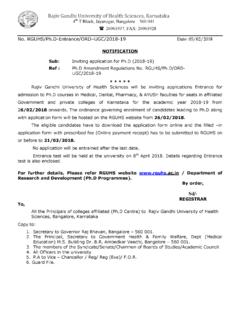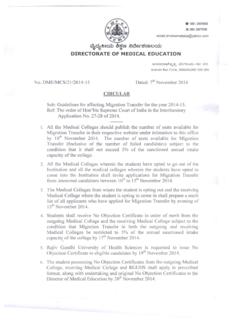Transcription of Evaluation of the H S Method for Detection of Fecal ...
1 WHO/SDE/ : LimitedEnglish onlyEvaluation of the H2S Method forDetection of Fecal contamination ofDrinking WaterWater, Sanitation and HealthDepartment of Protection and the Human EnvironmentWorld health OrganizationGeneva World health Organization 2002 The illustration of the cover page is extracted from Rescue Mission: Planet Earth, Peace ChildInternational 1994; used by permissionThis document is not issued to the general public and all rights are reserved by the World HealthOrganization. The document may not be reviewed, abstracted, quoted, reproduced or translated, in partor in whole, without the prior written permission of WHO. No part of this document may be stored in aretrieval system or transmitted in any form or by any means electronic, mechanical or other withoutthe prior written permission of views expressed in documents by named authors are solely the responsibility of those : LimitedEnglish onlyEvaluation of the H2S Method forDetection of Fecal contamination ofDrinking WaterPrepared byMark D.
2 Sobsey and Frederic K. PfaenderDepartment of Environmental Sciences andEngineering, School of Public HealthUniversity of North Carolina, Chapel Hill, NC 27599 TABLE OF CONTENTS PageForeword .. Indicator Detection and Testing in drinking water : Context, Purposes, Needsand Criteria .. water Safety Plans and Detecting Fecal indicators in drinking and Needs for Detecting Indicators of Fecal contamination in for detecting Fecal contamination of drinking water using presence-absence tests and their use in detecting and quantifyingfecal , disadvantages and limitations of tests for bacterial indicators of for and benefits of alternative tests to detect Fecal contamination of and Historical Development H2S H2S Tests Measure and How They Measure Sulfide and the Biogeochemistry of reducing bacteria and H2S tests.
3 Possible limitations or sources of misinterpretation in the H2S test .. Test Procedures: Media, Formats and Test Conditions .. of H2S Tests to Other Tests for Detecting Fecal contamination of water .. if H2S Tests Meet the Criteria of an Ideal or Preferred Indicator ofFecal contamination .. modifications of the H2S test to improve specificity for H2S-producingbacteria of Fecal of H2S Tests .. and Conclusions .. Cited .. 32 TablesTable 1 Microbial sources of hydrogen sulfide in water and other environmental 9 Table 2 Microorganisms capable of producing hydrogen sulfide .. 12 Table 3 Comparisons of Media, Materials and Methods for the H2S Test in Different Reported 17 Table 4 Comparison of H2S and Standard Bacteriological Tests Applied to Various Samples .. 21 Table 5 Fecal Indicator Criteria for Fecal contamination and the Extent to Which they are Met inReported Studies of H2S Tests .. 266 FOREWORDA round million die of basic hygiene related diseases, like diarrhoea, every great majority are children in developing countries.
4 Interventions in hygiene,sanitation and water supply make proven contributors to controlling this diseaseburden. For decades, universal access to safe water and sanitation has been promotedas an essential step in reducing this preventable disease burdenNevertheless the target of universal access to improved water sources and basicsanitation remains elusive. The Millenium Declaration established the lesser butstill ambitious goal of halving the proportion of people without access to safe waterby provision of drinking water of acceptable microbiological quality and lowinfectious disease risk requires a number of essential elements within a water SafetyPlan. Within any water safety plan emphasis is placed on controlling and detectingfecal contamination of drinking water and its sources. Traditionally, this measure offecal contamination has been a bacterium or group of bacteria considered indicative offecal contamination .
5 The measurement of such indicator bacteria of fecalcontamination requires trained analysts, media and other supporting materials andfacilities available only in a microbiology laboratory or the use of a watermicrobiology field analysis of access to laboratories or field analysis kits is an obstacle to the provision ofmicrobiologically safe drinking water to many communities and people worldwide. Inan effort to overcome this problem, a number of alternative indicators and tests todetect Fecal contamination of drinking water have been proposed and of these proposed Fecal indicators and their tests are simple, low cost and do notrequire a microbiology laboratory or bacteriological field test kit. Some of thesesimple, low cost Fecal indicator tests have come into use in actual drinking watersupply practice.
6 Prominent among these is the so-called hydrogen sulfide or H2S test,which is intended to detect or quantify hydrogen sulfide-producing bacteria,considered to be associated with Fecal purpose of this report is to review the basis of the hydrogen sulfide test as ameasure of Fecal contamination of drinking water and the available scientific andempirical evidence for and against the test as a valid, useful and reliable measure offecal contamination and drinking water quality. The report addresses the fundamentalmicrobiological considerations of the test, including its chemical and biochemicalbasis, what organisms it detects and how it detects and quantifies them and thereported experiences with its practical application to assessing water developing this report many sources of data and supporting information weregenerously provided by developers and users of the test and others who also haveattempted to modify, improve, validate and apply it.
7 We are grateful to these manyindividual and organizations for their assistance. In particular, we gratefully thank thefollowing for providing reports and other supporting information:Rajiv Gandhi National drinking water Mission, Ministry of Rural Development,Department of drinking water Supply, Government of IndiaUNICEF, New Delhi7Ms. Bettina Genthe, Division of water Environment and Forestry, CSIR,Stellenbosch, South AfricaThis report has been prepared as part of a programme of activity towards the updatingof WHO s Guidelines for drinking - water Quality. Following a process ofdevelopment and review it is released in draft document represents work in progress and further information concerning theH2S test and experience with its application would be welcome. Such informationshould be forwarded to:Dr Jamie BartramCoordinatorWater, Sanitation and health ProgrammeWorld health Organization20 avenue Appia1211 Geneva 27 Switzerland81.
8 INTRODUCTION AND BACKGROUNDThis report critically reviews the scientific basis, validity, available data and otherevidence for and against H2S tests as measures or indicators of Fecal contamination indrinking water . The test was originally developed to detect in a volume of water theproduction of H2S by enteric bacteria associated with Fecal contamination by theformation of a black precipitate from the reaction of the H2S with iron in the relatively simple, low cost test has been studied, modified in various ways, testedand used to some extent in many parts of the world as an indicator of fecalcontamination of drinking the initial report of the H2S test 20 years ago (Manja et al., 1982), manyversions or modifications of it have been described in the published literature. Hence,there are now many versions of the H2S test and these differ in medium composition,the preparation of the medium and supporting materials, test format and samplevolumes, incubation time, incubation temperature and scoring of results.
9 The test isnot standardized worldwide and only some versions of it have been subjected tocollaborative testing or comparison with other bacteriological tests for fecalcontamination. The plethora of different H2S test versions and the variety of waysthey have been evaluated in laboratory and filed studies make it difficult to comparethem. The essential criteria of any test to detect and quantify Fecal contamination ofdrinking water and other waters are used as the basis for evaluating the validity andperformance of various versions of the H2S test and the quality of the data availablefor Evaluation and validation INDICATOR Detection AND TESTING IN DRINKINGWATER: CONTEXT, PURPOSES, NEEDS AND water Safety Plans and Detecting Fecal indicators in drinkingwaterAn essential goal for the provision of safe drinking water is that it be essentially freeof (at low risk of containing) disease-causing microorganisms.
10 Since the beginning ofthe 20th century, the Detection of Fecal indicator bacteria in drinking water has beenused as the basis of criteria, guidelines and standards for acceptable limits of fecalcontamination and as the basis for judging or predicting the possible presence orabsence of pathogenic (disease-causing) microorganisms. The WHO Guidelines forDrinking- water Quality (GDWQ) and many other authorities continue to support theuse of bacterial indicator levels and their measurement as a basis for judging andverifying drinking water quality. However, such Fecal indicator analysis of drinkingwater as a measure of end-product quality and determinant of microbial disease risk isonly one of many measures and activities in an overall system for providing safedrinking water . In the updating of the WHO GDWQ, the goal of providing safedrinking water will be promoted through the development and use of a water SafetyPlan.















